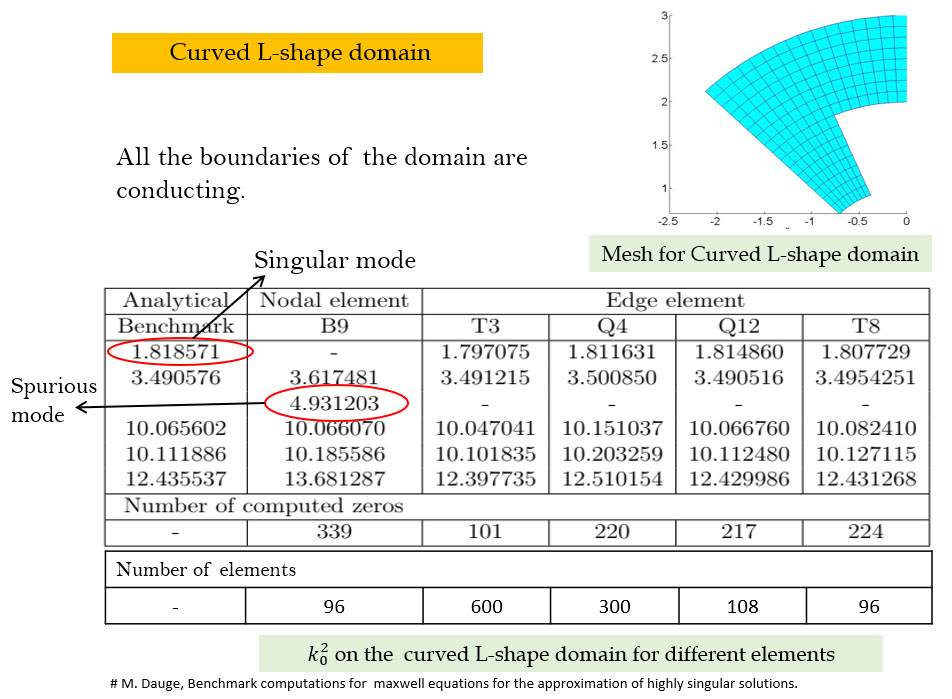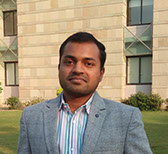
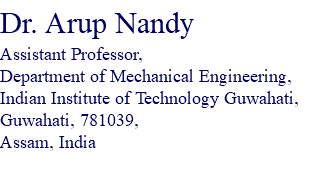
Contact Information:
Office: C-307,
Department of Mechanical Engineering,
IIT Guwahati, Guwahati, 781039,
India
Phone No.: +91-3612583441
email: arupn@iitg.ac.in
Explored Research Domains
- Transient Finite Element analysis in Structures, Acoustics and Electromagnetics
Advisor : Prof. CS Jog, IISc Bangalore
-
- Various new quantities are proposed in continuum framework, which are conserved under certain conditions, in the field of acoustics and electromagnetics.
- We have proved both algorithmically as well as with numerical examples that trapezoidal rule FEM mimic different conservation laws in all these domains. Hence, the time stepping strategy can be said to be 'unconditionally stable' (from an energy perspective) allowing the use of arbitrarily large time-steps.
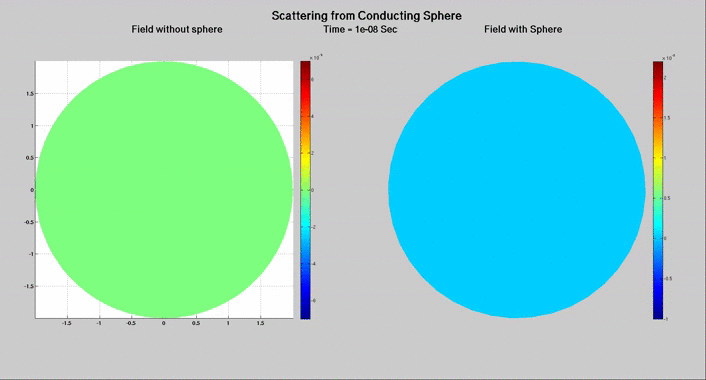
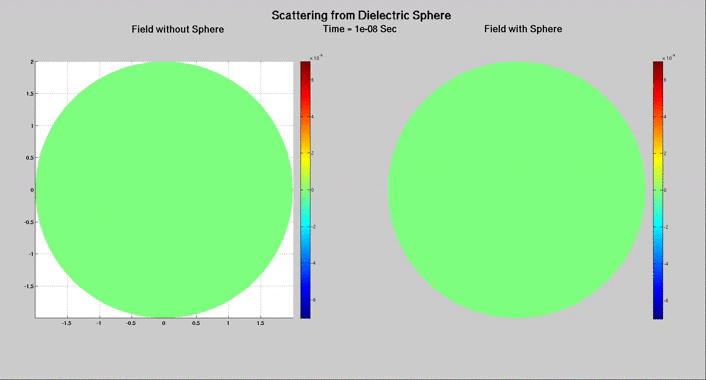
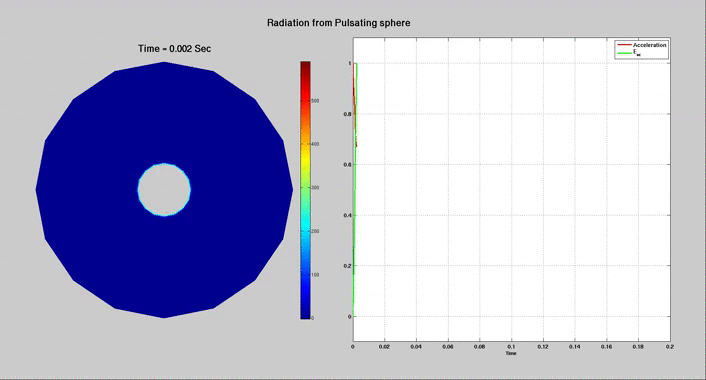
- Hybrid/mixed FEM formulation in Structures and Electromagnetics
Advisor : Prof. CS Jog, IISc Bangalore
Collaborator : Prof. Sachin Singh Gautham, IIT Guwahati, Prof. Manish Agrawal, IIT Ropar
Students : Dr. Dhiraj Bombarde, Silla Lakshminarayan
-
- For transient analysis in structures and structural acoustics far better efficiency is observed with hybrid element as compared to displacement based formulation. Advantages of hybrid elements are more pronounced at higher frequencies.
- We have implemented mixed FEM for eigen analysis in electromagnetics. This is the only strategy in nodal finite element which predict the null space accurately without adding any adhoc penalty term. It can handle sharp edges and corners, it can model inhomogeneous domain. In two dimension it works for all geometries; the only drawback is that it can not model curved geometries in three dimension.
- Isogeometric analysis (IGA) is a numerical technique in computational mechanics that benefits in maintaining the exact geometry during discretization, ease in attaining the higher inter-element continuity, and the significantly lower dependency on computer-aided design (CAD) for successive refinements.
- Hybrid Isogeometric Analysis (HIGA) is a two-field formulation developed to alleviate the different types of locking in locking-dominated problem domains by introducing a novel numerical scheme to approximate the independent stress field.
- Outward wave favouring Amplitude formulation for electromagnetic harmonic analysis in exterior domain
Advisor : Prof. CS Jog, IISc Bangalore
Students : Karanam Sreekanth
-
- Here, the highly oscillatory radial part of the field is separated out a-priori so that the Lagrange interpolation function has to capture a relatively gently varying function.
- We have solved a series of radiation and scattering problems, involving both conducting and dielectric bodies, including both convex and nonconvex domains. In all these cases proposed formulation has better coarse mesh accuracy than existing conventional formulation.




Amplitude formulation for exterior electromagnetic radiation and scattering problems
Radiation problem based on an axisymmetric analytical solution
Scattering from conducting cube and cylinder
Scattering from dielectric cube and dielectric sphere
<
>
2 - 4
- Edge element for electromagnetic analysis
Students : Dr. Durgarao Kamireddy, Parmodh Kumar, Saurabh Madhukar Chavan
-
- Edge elements are constructed by curl and divergence conforming spaces. Whitney introduced these elements in the field of FEM in electromagnetics.
- In this element electric fields are along the edge of the element satisfying required tangential continuity.
- In edge based FEM each element is formed by connecting the edges. Each edge of the edge element is formed by joining the two nodes of the element.
- Monolithic FEM strategy for coupled multiphysics domains
Advisor : Prof. CS Jog, IISc Bangalore
-
- Coupled problems with structural acoustics interaction are solved. Better coarse mesh accuracy with hybrid elements is also visible in coupled analysis.
- Incompressible magneto-hydrodynamics flow is modelled using continuous pressure velocity stable formulation, which ensures more stability and better coarse mesh accuracy than staggered stabilized formulation. Both transient and steady-state formulations are developed for two- and three-dimensional geometries.
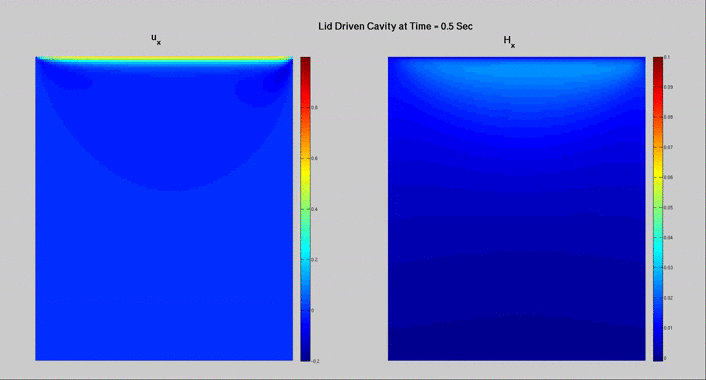
- Minimization of Radiated Sound Power of a vibrating Shell structures using FEM Analysis
Advisor : Prof. CS Jog, IISc Bangalore
-
- We have proposed an method for reducing radiated acoustic noise from 'light' fluid loaded structures. Here we minimize dynamic compliance (which is nothing but the input power) of the structure, which results in substantial reduction in the radiated sound power. Here we bypass the need for an acoustic and associated sensitivity analysis.
- In this work we keep the base structure unaltered, the location and thickness of the added stiffeners are decided using optimality criteria method to minimize the radiated sound.




Optimal design of stiffened plate and associated power graph at driving frequency 2000 rad/s
Optimal design of stiffened plate and associated power graph at driving frequency 11000 rad/s
Optimized shell design with transverse stiffeners for driving frequency 3000 rad/s
Optimized shell design with longitudinal stiffeners for driving frequency 9000 rad/s
<
>
1 - 4
- Electromagnetic Forming and Perforation: Experimental and Numerical Analysis
Collaborator : Prof. Sachin D. Kore, IIT Goa
Students : Dr. Sagar Pawar, Dinesh Ray, Avinash Chetry
-
- We have compared electromagnetic forming with conventional forming
- Electromagnetic forming and perforation of Al tubes: FEM Simulation in ANSYS and LS-Dyna have been successfully matched with experiment.














Electromagnetic Forming (EMF) Processes
Problem Description
Electromagnetic Perforation of tube
Observations
Finite element simulation
Validation
Advantages over Quasi-static Perforation Process
Analysis of the perforated tube
Electromagnetic forming of Muffler tube
Observed Results
<
>
10 - 10
- Electromagnetic Crimping for Tube-to-Tube joints: Experimental and Numerical Analysis
Collaborator : Prof. Sachin D. Kore, IIT Goa
Students : Dr. Deepak Kumar, Shafeeque E S, Avinash Chetry
-
- Electromagnetic Crimping for tube to tube joints: Different surface profiles have been analyzed.
- Electromagnetic crimping of Cu-SS Tube-to-tube joint : FEM Simulation in LS-DYNA and ANSYS have been successfully matched with experiment for both smooth and threaded surface.
.gif)
- Designing FEM tool with GUI interface
Advisor : Prof. CS Jog, IISc Bangalore
Other team members : R. P. Singh, Prof. Manish Agrawal, IIT Ropar, Vishwas Jayarama
-
- Active member of the group developing HyFem. HyFem is a package to solve problems in structures, acoustics, electromagnetics and various other domains. Its GUI interface for preprocessing and post processing is in Matlab where as the analysis code is written in Fortran.






